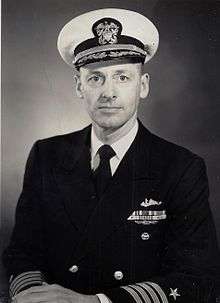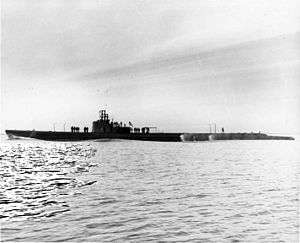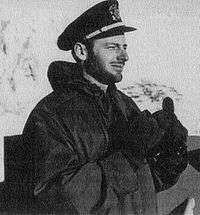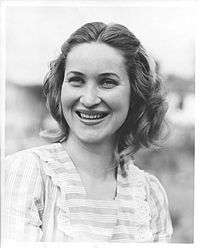Robert D. McWethy
Robert Devore McWethy (January 5, 1920 – January 29, 2018) was a United States Navy Captain and submariner who fought in the Pacific during World War II and later pioneered submarine navigation under the Arctic ice pack.[1] Capt McWethy received the Legion of Merit for his role in the development of SOSUS underwater listening posts as Commander, Oceanographic Systems Atlantic.[2] From the 1970s on he was also active in support of sailing in the navy and at the U.S. Naval Academy.
Robert Devore McWethy | |
|---|---|
 Capt. Robert D. McWethy | |
| Nickname(s) | Bob, Mac |
| Born | January 5, 1920 Aurora, Illinois |
| Died | January 29, 2018 (aged 98) |
| Allegiance | |
| Service/ | |
| Years of service | 1938-1972 |
| Rank | Captain |
| Service number | 0-123488/1100 |
| Battles/wars | World War II Korean War Vietnam War |
| Awards | Silver Star Legion of Merit |
| Spouse(s) | Margaret Elizabeth McWethy |
| Other work | US Naval Sailing Association |
Early years
McWethy was born on January 5, 1920, the son of J. LeRoy and Zula Miller McWethy. In 1939, McWethy enrolled in the United States Naval Academy where he was involved with sailing and golf, although the Lucky Bag yearbook noted that "his class standing is far nearer perfection than his golf swing."[3]
Career
World War II and service in submarines

McWethy graduated from the Naval Academy in 1941 as a part of the wartime class of 1942, and was assigned to the heavy cruiser USS San Francisco (CA-38), operating in the southwest Pacific. After two engagements with the enemy, the ship returned to Pearl Harbor. McWethy received orders to submarine school
McWethy went in April 1942 to USS R-13 (SS90) in Key West then in July to submarine school in New London. Standing high in the class, he was able to choose duty assignment in October to USS Pogy (SS266) under construction at Manitowoc,WI. After sea trials in Lake Michigan, it was down the Mississippi and on to Pearl Harbor. Pogy made six successful war patrols from Pearl and Midway Island, accounting for 23 enemy ships and avoiding being one of the 52 U.S. submarines lost in the war. In the summer of 1944 after Pogy had returned to the West Coast for overhaul, McWethy was rotated out of combat, going from fourth officer in Pogy to command USS R-10 (SS87) in Key West for the last year of the war.

After the War, McWethy had a number of additional assignments on submarines, Executive Officer of USS Picuda (SS-382) then as Executive Officer of USS Skate (SS-305).[4] Skate was a target ship for the 1946 A-bomb tests at Bikini.
1951-1952, LCDR McWethy was a student at the Naval War College in Newport.[5] From 1952 to 1954,he commanded the submarine USS Piper. His successor as captain, Marmaduke G. Bayne (later a Rear Admiral), remarked in an interview with the Naval Historical Foundation that "Bob McWethy was probably the best ship handler I have known. He was one with the ship."[6]
Navigation of the Arctic

In 1948, while teaching navigation at the General Line School in Monterey, McWethy learned the Air Force was making weather flights to the North Pole. He was able to participate in the 103rd mission in B29 out of Fairbanks, AK. McWethy was interested to see that there were areas of open water in the Arctic, and realized that submarines would be able to surface if the conditions were right.
“The idea of submarines operating beneath the ice soon became an obsession for McWethy,” wrote William R. Anderson in The Ice Diaries: The Untold Story of the Cold War’s Most Daring Mission. “Russia was the new threat. The Arctic region was in Russia’s backyard, What better platform from which to stealthily operate and keep an eye on them than a submersible ship?"[1]
Working with his friend Waldo Lyon, McWethy was instrumental in drawing up the Pentagon's plans for navigation of the Arctic by nuclear submarine in 1957. As chief-of-staff for Submarine Squadron 10, wrote the orders that sent USS Nautilus on its secret crossing underneath the North Pole on August 3, 1958.[7][8]
Development of SOSUS
In 1950 the Committee on Undersea Warfare of the National Research Council recommended study and development of underwater sensors to detect and track maritime traffic. Over the next decade, the Navy's Oceanographic Systems Atlantic command (OSL) began installing these SOSUS listening devices and monitoring them from NAVSEC facilities such as Ramey AFB, Grand Turk, Shelburne, and Nantucket. A primary task of SOSUS was to support anti-submarine warfare by detecting, classifying, and tracking submarine activity.
McWethy was assigned to OSL in 1961. "It was an exciting time," he recalled in a speech in 2004. "The Soviets had just started sending nuclear submarines into the Atlantic."[9] The new Charlie, Victor, and Yankee-class Soviet submarines were quieter and more difficult to detect.
McWethy was appointed Commander Oceanographic System Atlantic (COSL) in June 1965 and commanded SOSUS operations in the Atlantic for three years[10] His office expanded deployment of SOSUS in the Atlantic, especially in the GIUK gap, and opened NAVSEC stations in Keflavik and Argentia.
McWethy recalled that in 1966, the Secretary of the Navy (SecNav) Paul Nitze was visiting the COSL office when a Soviet November class was detected "snooping around Bermuda." With the aid of the SOSUS hydrophones, "he could see what the submarine was doing and where it was. The SecNav was impressed." SOSUS devices provided critical data in helping locate the submarines USS Thresher and K-129, which both sank with the loss of all hands.
McWethy received the Legion of Merit for "exceptionally meritorious" work on SOSUS. He "successfully directed the widespread operations of the Atlantic Oceanographic System during a period of considerable growth and improvement," according to his citation, "and was "responsible for greatly improved classified oceanographic systems and techniques of great importance to the security of the United States."[11]
Personal life

In 1942, McWethy married Nanette Zirker and the couple had two sons. Nanette died from complications of a ruptured appendix in 1947
In 1951, McWethy married Margaret "Liz" Clarke, the daughter of Capt (later Admiral) William P. O. Clarke, whom he had first met as a midshipman in 1938. They had a son, Navy CDR William C. McWethy, and three daughters, Martha Boynton, Margaret McWethy Bodie, and Melissa McNitt.
After McWethy's retirement in 1970, he and his wife Liz lived in an 1850s farmhouse on Weems Creek and were heavily involved in efforts to preserve the environment of the Severn River in Maryland, and particularly Weems Creek. In 1993, the Annapolis Capital Gazette reported on the couple's preservation efforts, including Liz McWethy's threat to "strip naked and chain her body to a tree to save the woody banks" of the creek. Liz served as Chairman of the Weems Creek Conservancy.[12] McWethy died in January 2018 at the age of 98.[13]
Sailing
Capt. McWethy had been an active sailor since his days at the Naval Academy. "In the fall he spends his week-ends sailing," noted his Lucky Bag yearbook, "and with the coming of spring he is torn between the golf course and the Bay."[3]
After retirement, McWethy became involved with the sailing program at the U.S. Naval Academy. In 1980 he was the third recipient of the A.G.B. Grosvenor Award for "exemplary contributions to the mission and programs of the sailing squadron." In 1985, Yachting Magazine wrote that "Bob McWethy, a retired captain who has been a continuing stablizing factor at Annapolis as offshore coach and race-committee head for midshipman sailing, is also a sparkplug in USNSA as its secretary."[15]
The Robert D. McWethy Fund sponsored by the US Naval Sailing Foundation raises funds to honor McWethy's 35 years of service to Navy Sailing.[16]
Awards
Capt. McWethy received the Silver Star Award for his actions as Torpedo Officer during a War Patrol in enemy-controlled waters of the Pacific Ocean which resulted in the sinking of two Japanese freighters and a 20,000-ton transport and in the successful evasion of severe enemy countermeasures.[17]
He received the Legion of Merit for his role as Commander Oceanographic Systems Atlantic.[17]
McWethy received the Alexander G.B. Grosvenor Award in 1980 for 35 years of service to Navy Sailing.
Further reading
- Anderson, William R. with Don Keith, The Ice Diaries: The Untold Story of the Cold War's Most Daring Mission'',[8]
- Calvert, CDR James F., “Up Through the Ice of the North Pole,” National Geographic, July 1959
- Grosvenor, Edwin S., "Secret Race to the Pole," American Heritage Magazine, Winter 2018.
- Lalor, Jr., LT William G., “First Crossing of the Ends of the Earth: ‘Submarine Through the North Pole,’ National Geographic Magazine, January, 1959
- Leary, William M., Under Ice: Waldo Lyon and the Development of the Arctic Submarine, (Texas A & M University Military History.
- Life Magazine, “Epic Voyage of ‘Nautilus’: The Crew’s Own Story,” September 1, 1958, plus 12 color pages
Writings
- "Arms Control and the Navy: When does a ship become an armament for negotiating purposes?", Naval Review Annual, 1966. United States Naval Institute.[18]
- “The Arctic Submarine,” Naval Institute Proceedings, Sept 1952, p. 955 (4 p)
- “Significance of the Nautilus Polar Cruise,” Naval Institute Proceedings, May 1958, p. 32 (4 p)
References
- Keith, William R. Anderson with Don (2008). The ice diaries: the untold story of the Cold War's most daring mission. Nashville, TN: Thomas Nelson. p. 64. ISBN 0785227598.
- "Robert Devore McWethy: Legion of Merit citation".
- Lucky Bag Yearbook. US Naval Academy. 1945. p. 141.
- SUBMARINE COMMANDERS by USNA Class. p. 5.
- The United States Naval War College Register of Officers, 1884-1979. Newport, R.I.: Naval War College. July 11, 1975. p. 102.
- Winkler, PhD., David F. "Oral History: Vice Admiral Marmaduke G. Bayne U.S. Navy (Retired), July 16-August 26, 1998" (PDF). Naval Historical Foundation.
- Grosvenor, Edwin S. (January 30, 2018). "Secret Race to the Pole". American Heritage Magazine. 63 (Winter 2018).
- Anderson, William R. (2008). The Ice Diaries: The Untold Story of the Cold War's Most Daring Mission. Thomas Nelson. ISBN 9781418574017.
- McWethy, USN (Ret.), Capt. Bob. "Politics in Promotion (or how I became COSL), a speech IUSS/SOSUS Dinner Speech, 50th Anniversary" (PDF). 18 SEPTEMBER 2004.
- Commander, Undersea Surveillance (CUS). "IUSS/SOSUS HISTORY (1950 – PRESENT)" (PDF). Document Certified to be unclassified by CNO-872A & IUSS Authorities.
- "Awards for Robert Devore McWethy". MilitaryTimes.com. Military Times.
- Williamson, Laura (March 3, 1993). "Weems Creek is her passion". Annapolis Capital Gazette.
- Robert McWethy Obituary
- Robinson, Bill. "Alive and Well". Yachting Magazine (May 1985): 93.
- Howe, USN (Ret.), Executive Director, LCOL Robert L. "US Naval Sailing Foundation" (PDF). US Naval Sailing Association Newsletter (Summer 2005): 2.CS1 maint: multiple names: authors list (link)
- "Valor Awards for Robert Devore McWethy". Military Times.
- McWethy, Robert (1965). "Arms Control and the Navy". Naval Review Annual 1966.